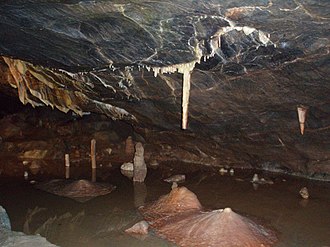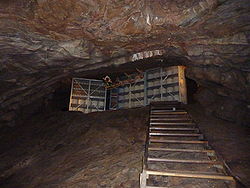Gough's Cave
| Gough's cave | |
| Somerset | |
|---|---|
 Stalagmites and stalactites in Gough's cave | |
| Location: | Cheddar |
| ST467539 | |
| Co-ordinates: | 51°16’53"N, 2°45’51"W |
| Depth: | 300 feet |
| Length: | 7,000 feet |
| Access: | Show cave open to the public; greater part by diving only |
| Geology: | Limestone |
Gough's Cave is a deep, limestone cave within the Mendip Hills of Somerset whose mouth is in Cheddar Gorge, by the village of Cheddar. The cave is 300 feet deep and is two miles long,[1] containing a variety of large chambers and rock formations. It is opened to the public as a show cave.
Within the cave is the Cheddar Yeo, the largest underground river system in Britain.[2]
History
The initial sections of the cave, previously known as Sand Hole, were accessible before the 19th century.[3] Between 1892 and 1898 Richard Cox Gough, who lived in Lion House in Cheddar, found, excavated and opened to the public further areas of the cave, up to Diamond Chamber, which is the end of the show cave today. Electric lighting was installed in the show caves in 1899.[4]
The cave is susceptible to flooding often lasting for up to 48 hours, however in the Great Flood of 1968 the flooding lasted for three days.[5]
The extensive flooded parts of the cave system were found and explored between 1985 and 1990.[4]
Human remains and occupation

The cave contained skeletal remains of both humans and animals, all showing cut-marks and breakage consistent with de-fleshing and eating. Skull fragments, representing from 5 to 7 people, including a young child of about 3 years and two adolescents. The brain cases appear to have been prepared as drinking cups or containers, a tradition found in other Magdalenian sites across Europe.[6]
In 1903 the remains of a man, since named Cheddar Man, were found a short distance inside Gough's Cave. He is Britain’s oldest complete human skeleton, having been dated to approximately 7,150 years BC.[7] There is a suggestion that the man died a violent death, perhaps related to cannibalism, although this has not been proven. Mitochondrial DNA taken from the skeleton has been found to match that of Adrian Targett, a man living in the local area today, indicating that Cheddar Man is a very distant ancestor.[8] The remains currently reside in the Natural History Museum in London, with a replica in the Cheddar Man and the Cannibals museum in the Gorge. Other human remains have also been found in the cave.
In 2007 a carving of a mammoth, estimated to be 13,000 years old, was found in the cave.[9]

In 2010 further human bones from the cave were examined, which ultra-filtration carbon dating dated to around the end of the ice age 14,700 years ago. A second technique, using the Alicona 3D microscope, showed that the flesh had been removed from the bones using the same tools and techniques used on animal bones. According to Professor Chris Stringer of the Natural History Museum, this supports theories about cannibalism amongst the people living in or visiting the cave at that time.[10] In February 2011, the same team published an analysis of human skulls of the same date found at the cave around 1987,[6] which they believe were deliberately fashioned into ritual drinking cups or bowls.[11]
Access and description

The first 900 yards of the cave are open to the public as a show cave, and this stretch contains most of the more spectacular formations.[4] The greater part of the cave's length is made up of the river passage, which is accessible only by cave diving.
Beyond the show cave


Gough's cave contains long stretches of completely flooded river passage. From a point relatively close to the areas of the cave open to the public, the cave-divers' descent into Sump 1a begins through a tight passage known as Dire Straits. The bottom of that passage opens into the river passage, which is several yards across. This has been explored for 370 yards downstream, whilst upstream a dive of 165 yards brings the diver out in a chamber 22 yards long chamber named Lloyd Hall (which can now also be reached by an alternative, dry, route).[4][12]
Another dive of 153 yards through Sump 1b, finishing with an ascent through a rising passage, leads to another chamber, 65 yards long and 27 yards wide at its widest point, and full of large boulders, called Bishop's Palace. This chamber is the largest chamber currently found in the Cheddar caves. Further on, three sump pools (named the Duck Ponds) lead to Sump 2 which is about 90 feet deep at its lowest point and 164 yards long.[4][12]
Air is again reached at Sheppard's Crook, which is followed by Sump 3. This sump is 180 feet deep and at its bottommost point is about 100 feet below sea level. Following Sump 3, a wide ascending passage continues for 400 yards before reaching an impassable blockage, still below the water's surface.[4][12]
| Sump | Length of dive[4] | Depth[4] | Emerging into[4] |
|---|---|---|---|
| Sump 1a | 490 feet | 60 feet | Lloyd Hall |
| Sump 1b | 460 feet | ? | Bishop's Palace |
| Sump 2 | 492 feet with airbells | 90 feet | Sheppard's Crook |
| Sump 3 | 1,215 feet | 180 feet | Passage blocked |
Outside links
- "Gough's Cave". Mendip Cave Registry & Archive. http://www.mcra.org.uk/registry/sitedetails.php?id=738.
- Cheddar Caves
- 'The Caves of Cheddar Gorge' by Tony Oldham
- Bones from a Cheddar Gorge cave show that cannibalism helped Britain's earliest settlers survive the ice age, Robin McKie, The Guardian, 20 June 2010
- Silvia M. Bello, Rosalind Wallduck, Simon A. Parfitt, Chris B. Stringer. An Upper Palaeolithic engraved human bone associated with ritualistic cannibalism, 9 August 2017
References
- ↑ "Gough's Cave". Mendip Cave Registry & Archive. http://www.mcra.org.uk/registry/sitedetails.php?id=738.
- ↑ "Cheddar Yeo". Somerset Rivers. http://somersetrivers.org/index.php?module=Content&func=view&pid=57. Retrieved 30 March 2010.
- ↑ Witcombe, Richard (2009). Who was Aveline anyway?: Mendip's Cave Names Explained (2nd ed.). Priddy: Wessex Cave Club. p. 83. ISBN 978-0-9500433-6-4.
- ↑ 4.0 4.1 4.2 4.3 4.4 4.5 4.6 4.7 4.8 Irwin, David John; Knibbs Anthony J. (1999). Mendip Underground: A Cavers Guide. Wells: Bat Products. ISBN 0-9536103-0-6. – which also contains a detailed description of the cave.
- ↑ Donovan, D.T. (2006). "Gough's Cave, Cheddar, Somerset. Quaternary Stratigraphy". Proceedings of the University of Bristol Spelæological Society 24 (1): 17–35. http://www.ubss.org.uk/resources/proceedings/vol24/UBSS_Proc_24_1_17-35.pdf. Retrieved 24 February 2011.
- ↑ 6.0 6.1 Bello, Silvia M.; Parfitt, Simon A.; Stringer, Chris B.; Petraglia, Michael: 'Earliest Directly-Dated Human Skull-Cups': PLoS ONE, 16 February 2011, Volume 6, issue 2; pages e17026
- ↑ "Gough's Cave excavation". Natural History Museum. http://piclib.nhm.ac.uk/piclib/www/image.php?search=cave&getnext=89335. Retrieved 2007-08-22.
- ↑ "Mendip caves: Cheddar Catchment". British Geological Survey. 2008. http://www.bgs.ac.uk/mendips/caveskarst/Caves_2.htm. Retrieved 2009-02-06.
- ↑ "Prehistoric cave carving hailed as 'one of most significant examples ever found in Britain'". Daily Mail. 2007-08-14. http://www.dailymail.co.uk/pages/live/articles/technology/technology.html?in_article_id=475286&in_page_id=1965. Retrieved 2007-08-22.
- ↑ McKie, Robin (2010-06-20). "Bones from a Cheddar Gorge cave show that cannibalism helped Britain's earliest settlers survive the ice age". The Guardian. https://www.theguardian.com/science/2010/jun/20/ice-age-cannibals-britain-earliest-settlers. Retrieved 20 June 2010.
- ↑ Amos, Jonathan (2011-02-16). "Ancient Britons 'drank from skulls'". BBC News. http://www.bbc.co.uk/news/science-environment-12478115. Retrieved 2011-02-17.
- ↑ 12.0 12.1 12.2 Thomas, Alan (1989). The Last Adventure. Wells: Ina Books. ISBN 1-869897-05-6. which contains a first-hand account of the exploration of the river passage by Richard Stevenson